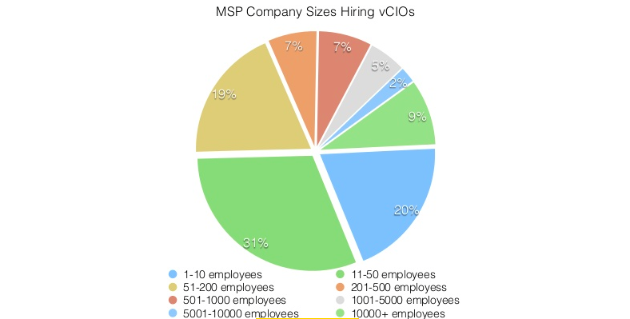
I was interested about the vCIO, vCTO, and Virtual Executive types of services. So my colleague Peter did some research on LinkedIn on the topic. Keep in mind everything herein is based on LinkedIn publicly accessible data...it’s interesting but there’s a limit to the depth of research you can do this way.So in general, I found that clearly the Virtual CIO industry is driven by the US. I can confirm this from personal experience, that American MSPs are much more comfortable with this term than European or even Canadian IT managed services providers.
- since 70% of vCIOs are hired by companies with under 200 employees, and 9% to large organizations (10,000+), there must be some local support need for interim or part-time high level IT executives.
- when looking at companies offering vCIO services, 97% have fewer than 50 employees and just over half (55%) have a staff roster of under 10.
Here’s our slide deck on our findings:
- 78% of vCIOs have more than 10 years experience, 16% between 6 and 10 - not surprising figures.
- the most essential roles of vCIOs are IT Consultant, Engineer, Sales, and Business Development. Interestingly 12% of identify as entrepreneur, in the sense that they are owners of an MSP organization.
- from what we see these vCIOs doing on LinkedIn, it seems that the largest collectors of these people is the cloud-related, and traditional CIO groups.
- 84% of these people exhibit little to no activity on the LinkedIn social network.
What I get out of this in summary is that there is no accepted academic definition of a vCIO, though companies do grasp the idea of a part time C-level executive assigned to the wheelhouse of their IT. The need is evident...just not widely recognized.
From this I see that we need to address the following: how to define and communicate the value proposition, the MSP sales funnel and the specific service offering that IT companies have invented to sell and deliver vCIO services.
The next step would be to define the vCIO roles and responsibilities and create a framework around their work. This would be required to disseminate this unrecognized need, and to enable the less resourced or less innovative IT managed services providers to start such services, and help the current vCIO practitioners to streamline their vCIO type of services.
See: 2019 Managed Services Platform vCIO Report and Managed Services Platform Account Manager Report 2019



